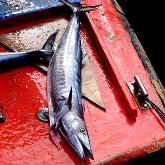Fish Recipes: Mussels in Curry Cream Sauce
August 7, 2012The History of the Life Preserver
August 21, 2012Very few anglers don’t have at least one fish story about the big one that got away, but if you want to talk really big fish it’s time to discuss the ocean sunfish. Also known as the mola mola or the common mola, the ocean sunfish is the largest fish in the world – specifically the heaviest bony fish. The average adult weighs 2,200 pounds, which means that when this big one gets away, it probably takes the boat with it.
What’s particularly interesting about these monster fish is that even though they’re huge any way you measure them, they live on a diet consisting mainly of jellyfish, salps, sea grass, and small sea creatures. That means mola mola have to eat a lot of what they eat. But you’ll probably be surprised that these giant fish start out tiny. Newly hatched sunfish larvae are just over 2 mm long, which isn’t even a tenth of an inch. The fry – which look like miniature puffer fish – will increase their bulk by a magnitude of millions before reaching adulthood.
Naturally, the biggest fish in the ocean doesn’t have a lot of predators. Orcas, sea lions, and sharks will occasionally take one down, 40 species of parasite call this fish home, and the ultimate predator, man, has been known to catch and consume the mola mola. However, outside of some Asian nations, the ocean sunfish is usually protected, though the species is frequently found in gillnets by accident. This may be because the docile ocean sunfish is naturally curious and is prone to investigating man made artifacts closely. Encounters with humans can play out a few ways. First, these gentle fish are a popular attraction for divers – mola mola will actually approach people in a friendly way, just to get a better look. Second, the ocean sunfish can damage boats and sustain injury in boating collisions caused by the fishes’ habit of sunning themselves close to the surface.
So far, we’ve shared two of this species’ names, but here are some others we like for their aptness. The Dutch, French, Portuguese, Spanish, Catalan, Italian, and Russian names for the mola mola all translate to moon fish because of the species’ unique rounded shape. In German, the ocean sunfish is sometimes referred to as the Schwimmender Kopf, which means swimming head. The Polish call it samogłów, meaning head alone. And indeed, it does resemble the head of a fish with fins sprouting from the top and bottom and a silly stumpy tail.
Pretty cool, right? If you ever have a chance to swim with these behemoths of the sea, don’t miss out!

